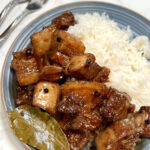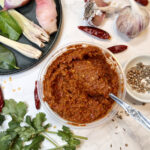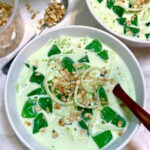Thai red curry paste is an intensely flavored paste composed of dried red chilies, fragrant aromatics, and dried spices.
I truly believe that Thai curry pastes are one of the greatest gifts to the culinary world. You can really taste the love and effort it takes to make these pastes, being the foundation in so many dishes that lends an incredibly rich and fragrant flavor.

I finally got down to making my own Thai curry paste from scratch, beginning with the standard red curry version. This recipe was inspired by two Thai chefs (who I trust Thai recipes with my life): Marion Grasby (from Marion’s Kitchen) and Pailin Chongchitnant (from Hot Thai Kitchen).
Thai Red Curry Paste
The “red” in Thai red curry paste comes from its main ingredient: dried red chilies. We use a hefty amount for this recipe in order to color our paste with that proper deep red look, but don’t be alarmed, we control the spiciness by removing most of its seeds.
Red curry paste (or any Thai curry paste, for that matter) can be used for a lot of different dishes -not solely reserved for curries. It’s a pulverized mixture of chilies, aromatics, and spices that’s a literal flavor bomb and limiting yourself to just sauces seriously undermines the potential of this paste.
I like to think of red curry paste as a basic or standard paste where I can use it in stir-fries, marinades, or even as seasoning rubs for meats and vegetables.

Comparison with Store-bought Pastes
Now you might be wondering, why go through all this work when I can just grab myself a large tub of this stuff from the grocery with minimal effort?
In fact, that’s what I would do (and what the majority would as well). Preparing your own curry paste from scratch, while not exactly difficult, can be time consuming -even with the use of a food processor.

The sole reason to make your own pastes is if you’re generally unsatisfied with what’s currently available in stores. Most commercial pastes already come pre-salted in order to lengthen and preserve its shelf life, restricting the overall control you have on the saltiness of homemade Thai dishes. Different brands also vary in terms of their flavor and spice levels.
Don’t get me wrong, there are seriously some good brands out there in the market (my current go-to’s including Mae Ploy and Aroy-D), but one of the best ways to truly customize and gain control over the taste of your red curry paste is to make it from scratch.
Ingredients for Thai Red Curry Paste
Thai red curry paste contains some very specific ingredients, most of which can be purchased in your local Asian grocery.
Try not to make too many substitutions to the ingredients or else the paste won’t taste quite right.
Dried red chilies: These are the ones that you’d typically see sealed in bags, sometimes sold as “whole dried chilies”. Note that these are not the same as the fresh Thai chilies, which are considerably spicier and less earthy in taste compared to the dried variant.
Aromatics (shallots, garlic, galangal, lemongrass, makrut/kaffir lime leaves, cilantro stems): These form the foundation of our curry paste, making it very aromatic. I do find that galangal and the lime leaves tend to be tougher to break down, so I make an effort to mince them finely (or even pound them) to make the work easier for my food processor.
Spices (coriander, cumin, white peppercorns): You can use either pre-ground or whole spices for this. I do prefer the whole spices however just because they tend to be more potent in flavor when freshly ground.
Shrimp paste: Traditionally, you’ll want to use a Thai fermented shrimp paste called gapi, which gives the paste a depth of umami and funkiness. I, for the life of me, could not find this at all in my city so I opted for bagoong (Filipino shrimp paste). I know, not traditional, but I find it works as a good substitute anyways along with belacan (Malaysian shrimp paste).
Instructions
Soak the dried red chilies in warm water for at least 30 minutes to soften (you can soak these while preparing the rest of your ingredients).

In a pan over medium heat, toast the coriander seeds, cumin seeds, and white peppercorns until lightly toasted and fragrant, about 3 minutes. Transfer the toasted spices into a mortar and pestle or spice grinder and grind into a fine powder. Set aside.


Lightly oil your pan. Over medium-high heat, add the shallots, garlic, galangal, lemongrass, cilantro stems, and makrut/lime leaves. Evenly spread the aromatics over the pan and allow to lightly char on all sides (we’re not really sautéing or cooking the aromatics here, just simply browning them to achieve a deeper flavor).
Be careful not to burn the aromatics or your paste will become bitter. Once deeply browned, remove the aromatics from the heat and set aside.

Into your food processor, add in the soaked chilies (without the water), ground spices, aromatics, shrimp paste, and kosher salt. Process/blend the ingredients until you achieve a fine paste consistency.


How to store Thai Red Curry Paste
Since these are homemade, the shelf-life of the paste will be considerably shorter than store-bought versions (hence why these are best used the day-off or for the next 2-3 days).
Otherwise, you can increase its shelf-life by freezing and sealing the pastes in air-tight containers/bags if not using right away.
Disclosure: Some links on this page are affiliate links, meaning that at no additional cost to you, we may receive compensation from purchases made through these links. As an Amazon Associate, I can earn from qualifying purchases.








Pingback: Khao Soi (Thai Curry Noodle Soup) | Iankewks